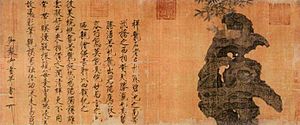Chinese scholar's rocks facts for kids
Chinese scholars' rocks (also called gōngshí, scholar stones, or viewing stones) are special rocks. They are naturally shaped and were highly valued by Chinese scholars for a long time. These rocks can be any color and come in many sizes. Some are very small, weighing less than a pound, while others can weigh hundreds of pounds. The term "scholar's rock" also refers to stones used in traditional Chinese gardens.
Contents
History of Scholar's Rocks
Chinese scholars have admired these unique rocks for centuries. During the Tang Dynasty, which was a long time ago, people started to look for four main qualities in these stones. These qualities helped them decide if a rock was truly special.
What Makes a Scholar's Rock Special?
The four important qualities recognized in the Tang Dynasty are:
- Thinness (shou): The rock should look slender or delicate.
- Openness (tou): It should have holes or open spaces.
- Perforations (lou): This means it has many small holes or tunnels going through it.
- Wrinkling (zhou): The surface should have interesting textures or folds, like wrinkles.
Chinese scholar's rocks also inspired similar art forms in other countries. For example, they influenced suseok in Korea and suiseki in Japan.
Where Do Scholar's Rocks Come From?
The place where a scholar's rock was found is an important part of its story. Some of the most famous types of these stones come from specific areas in China.
Famous Types of Scholar's Rocks
Here are some well-known origins for these unique stones:
- Lingbi stone (Lingbishi) from Lingbi County, Anhui province. These are a type of limestone.
- Taihu stone (Taihushi) from Lake Tai, Jiangsu province. These are also limestone.
- Yingde stone (Yingshi or Yingdeshi) from Yingde, Guangdong province. These are another type of limestone.
How Scholar's Rocks Are Valued
When people evaluate a scholar's rock, they look at many things. They pay attention to its color, shape, any natural markings, and how its surface feels.
Qualities of a Valued Scholar's Rock
Some of the most prized qualities include:
- Unique Shape: The rock might have an unusual or odd shape, or an interesting kind of balance (awkward or odd symmetry).
- Sound: If you gently tap the stone, it might make a special ringing sound (resonance).
- Resemblance: The rock might look like a landscape, a mountain, an animal, or even a human figure.
- Texture: How the surface feels is important. Is it smooth, rough, or something else?
- Surface Look: The stone might have a shiny or wet-looking surface (moistness or glossy surface).
Often, these stones are displayed on a special wooden base. This base is carved to fit the unique shape of each rock perfectly. Scholar's rocks have also been a popular subject in traditional Chinese paintings for many years.
Related pages
Images for kids
See also
 In Spanish: Gongshi para niños
In Spanish: Gongshi para niños








